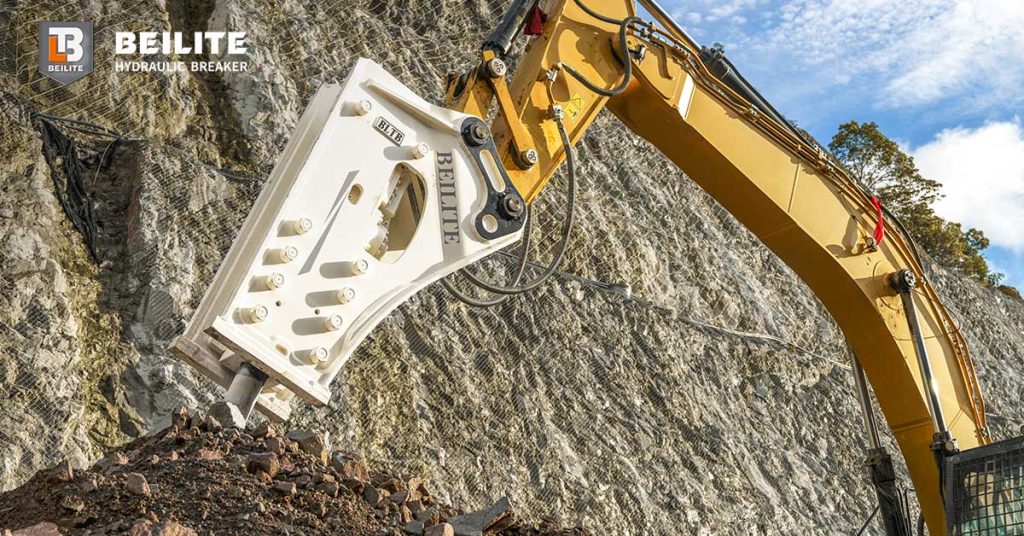
5 Tips for Replacing Your Hydraulic Breaker
19 August 2025
When to replace your hydraulic breaker?
Knowing when to replace your hydraulic breaker can mean the difference between high uptime and unexpected equipment failure on critical jobs. While these tools are engineered for rugged environments, no hydraulic hammer lasts forever. Ignoring the warning signs of severe wear or damage can lead to escalating maintenance costs, structural failures, and even safety risks.
So how do you know whether it’s time to replace rather than repair? we’ll walk through key indicators of end-of-life for hydraulic breakers, share field-tested decision-making frameworks, and explain how BEILITE designs tools that last longer in demanding conditions like quarrying, demolition, and underground tunneling.
Why Hydraulic Breakers Don’t Last Forever
Every hydraulic breaker undergoes extreme mechanical stress. Thousands of high-frequency impacts per minute cause gradual fatigue in the piston, front head, and bushings. Eventually, repairs become too frequent or too expensive relative to the breaker’s value.
Even with good maintenance, common wear mechanisms include:
- Piston scoring or cracking from misaligned impacts or poor lubrication
- Tool and bushing wear that can no longer be shimmed or replaced
- Cracks in the cylinder housing or breaker box from accumulated stress
- Internal leakage caused by permanent deformation of sealing surfaces
Just like an excavator or haul truck has a replacement threshold based on usage hours and cost-of-repair ratios, your breaker hammer should be assessed using clear performance and cost data.
5 Telltale Signs Your Hydraulic Breaker Needs Replacing
Let’s break down the most common red flags indicating that your hydraulic breaker may have reached the end of its useful life.
1. Chronic Oil Leaks and Seal Failures
When the seal kit has been replaced multiple times in a season and you’re still getting leaks, this is a sign that internal components (like the cylinder or valve housing) are worn beyond tolerance. Leaking oil isn’t just a mess—it reduces performance and puts your entire hydraulic system at risk.
2. Excessive Piston Damage
The piston is the heart of the breaker. If it becomes scored, cracked, or bent, it can lead to abnormal impact patterns and damage to the tool and bushings. Severe piston damage is often a sign of systemic misalignment or frame fatigue—both of which justify a full replacement.
3. Recurring Front Head Bushing Failures
If your inner and outer bushings are wearing out abnormally fast, even after recent replacements, the front head may be ovalized or cracked. Repairing or machining this part repeatedly becomes cost-prohibitive over time.
4. Unstable Nitrogen Pressure in the Accumulator
When your accumulator can’t hold nitrogen pressure for more than a few shifts—even after diaphragm or charging valve replacement—it’s time to consider replacement. Persistent failure here reduces impact energy and risks damaging the carrier.
5. Cracked or Distorted Housing
Visible cracks in the breaker box, distorted side plates, or elongation of bolt holes indicate frame fatigue. These issues are safety-critical and can’t always be repaired effectively, especially if the unit has suffered a side load or a dropped tool impact.
What Causes Accelerated Wear in Breakers
Even a high-quality hydraulic hammer can wear out prematurely if used improperly. Here are the biggest contributing factors:
- Incorrect Carrier Matching: Using an oversized breaker on a light excavator reduces flow and impact energy; undersized breakers overstress internal parts.
- Lack of Lubrication: Skipping tool greasing causes bushing wear and tool seizure. A manual grease gun might be missed during busy shifts—an automatic lubrication system can solve this.
- Dry Firing: Striking without contact leads to recoil energy being absorbed by the piston instead of the material.
- Misuse on Non-Suitable Materials: Using a blunt tool on high-strength granite or a moiled point on soft asphalt reduces efficiency and increases stress on the breaker.
- Improper Nitrogen Charging: Over- or under-charging the accumulator leads to inconsistent impact energy and internal stress.
on your fleet, material type, and usage pattern.